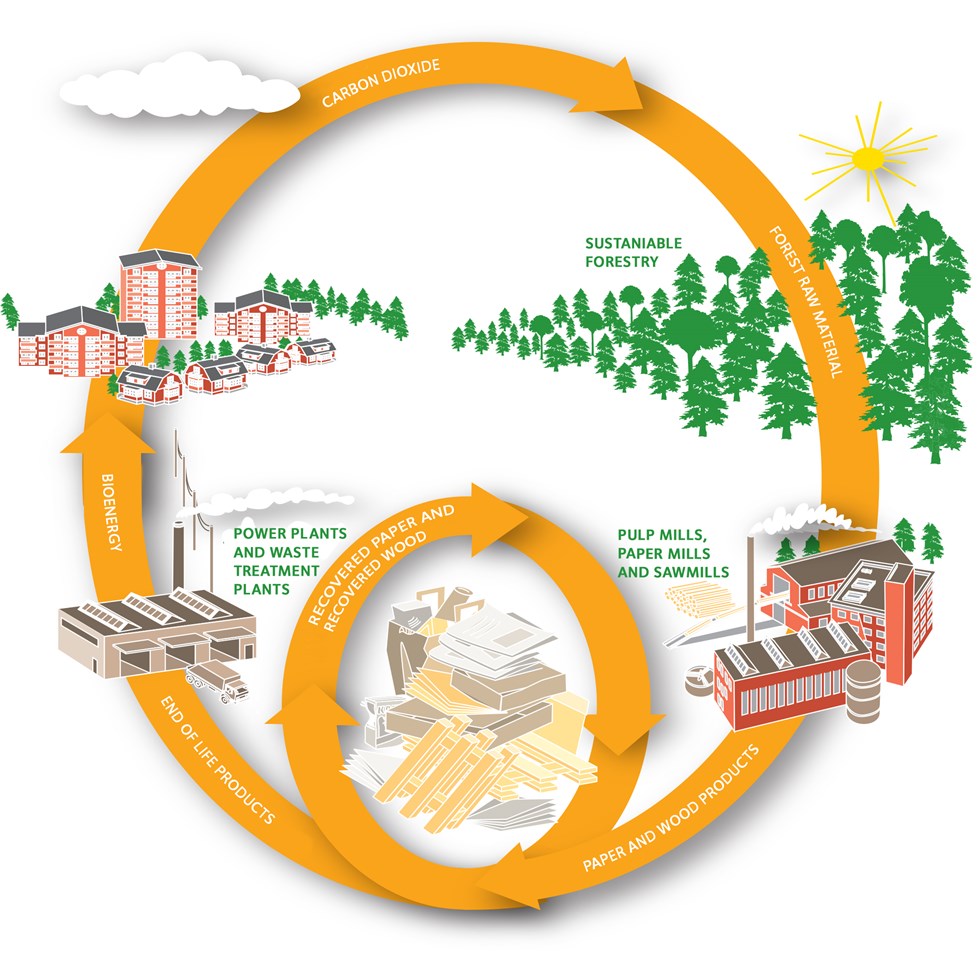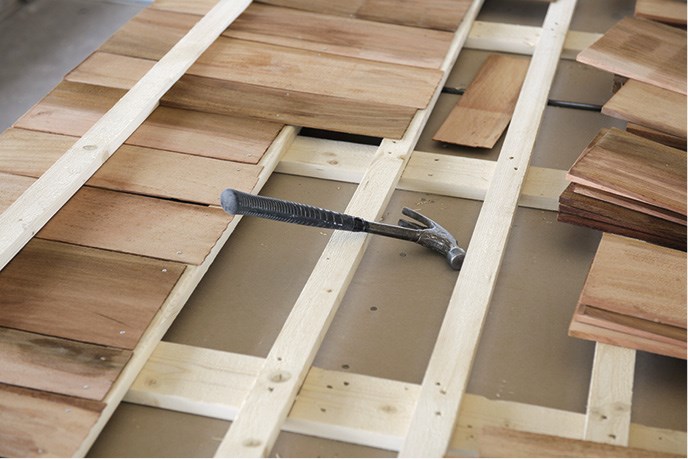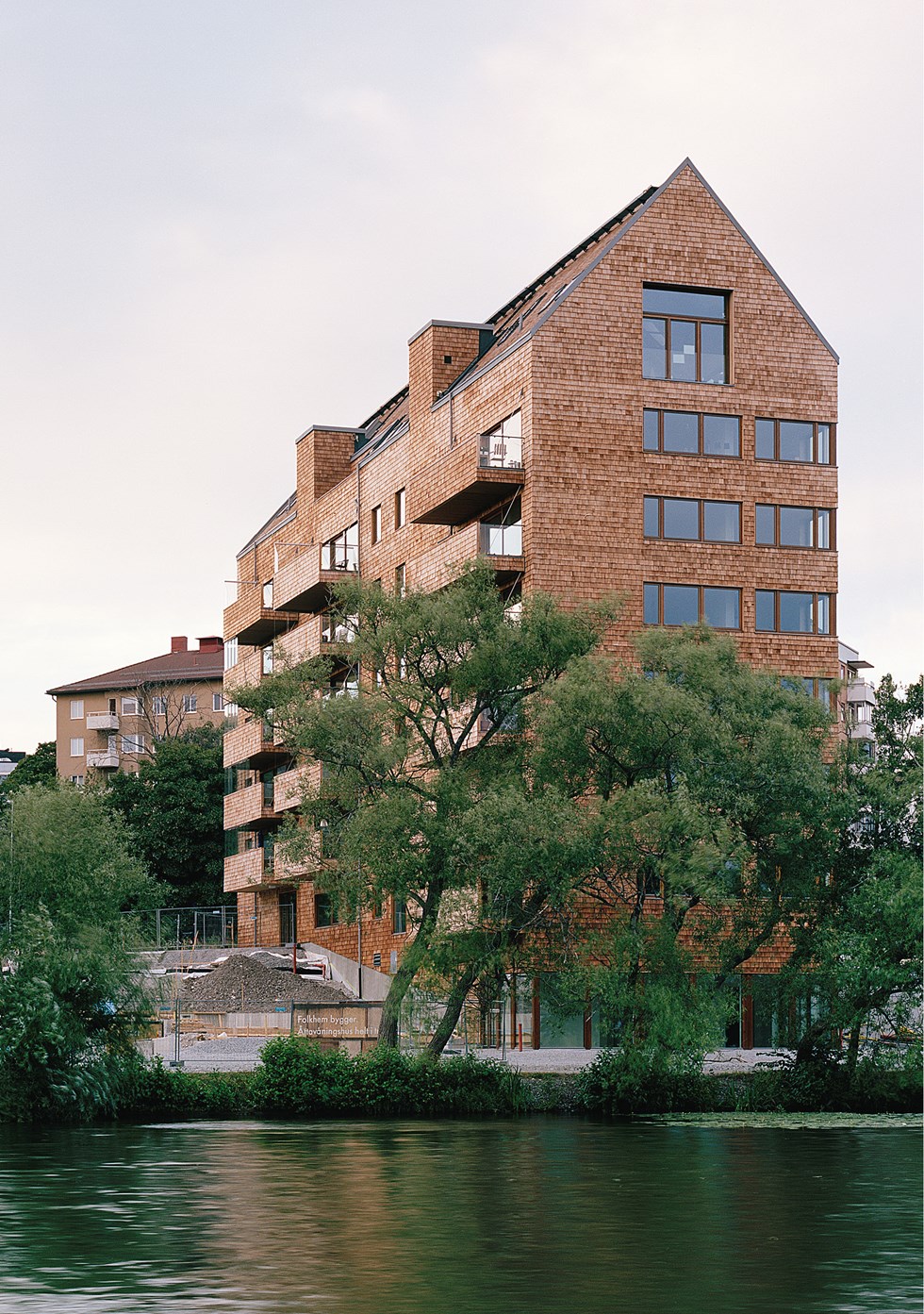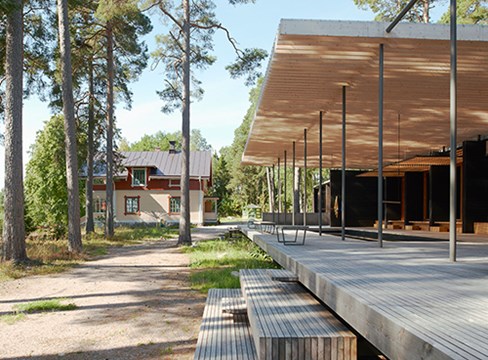Wood is a sustainable construction material
Wood is a versatile raw material and the only renewable construction material. Wooden structures are usually characterised by a combination of different components that together deliver the best possible load-bearing capacity, thermal, acoustic and moisture insulation, fire resistance and a long service life.
Increasing the proportion of wood in construction can facilitate a reduction in the use of other construction materials, such as concrete, steel and brick. These construction materials don’t come from renewable raw materials, they require a great deal of energy for their production and they entail higher emissions of carbon dioxide.
The EU’s long-term plan for a competitive economy with low carbon emissions is called Roadmap 2050. The key driver of this transition will be energy efficiency. A low carbon economy will have much greater need for renewable energy sources, energy-efficient manufacturing of construction materials, energy-efficient structures and low-energy modes of transport.
In this context, the construction sector has opportunities over the short and long term to reduce emissions of carbon dioxide through the choice of materials with a low environmental impact and through energy-efficient structures. Increasing the use of wood products is part of the solution.
Production of different construction materials
The past two decades have seen the rapid development of wood in architecture, as a result of the EU’s switch to function-focused standards in the member states’ building regulations. This now makes it possible to build larger buildings using wood-based systems.
Manufacturing wood products requires the input of very little external energy, over and above the energy from their own by-products. 80 percent of the energy consumed by Sweden’s sawmills derives from biofuels from their own production lines, such as bark and shavings, while 20 percent is electrical energy. The most energy-intensive stage of the process is the drying of boards and planks. This is also the stage that uses most electrical energy to run the fans in the dryers.
When manufacturing other construction materials, the starting point is always finite raw materials. Both extraction and processing require energy, often in very large quantities and from fossil fuels.
The manufacture of cement generates substantial carbon emissions, as do the processes for making steel. All the construction materials produced by these processes therefore have a positive carbon footprint.
This measure of a product or activity’s emissions of carbon dioxide and other greenhouse gases helps the user to opt for the alternative with the lowest impact on the climate. Wood is carbon negative since carbon dioxide is stored in the original wood and the emissions associated with harvesting, transport and processing are small compared with the quantity of stored carbon dioxide.
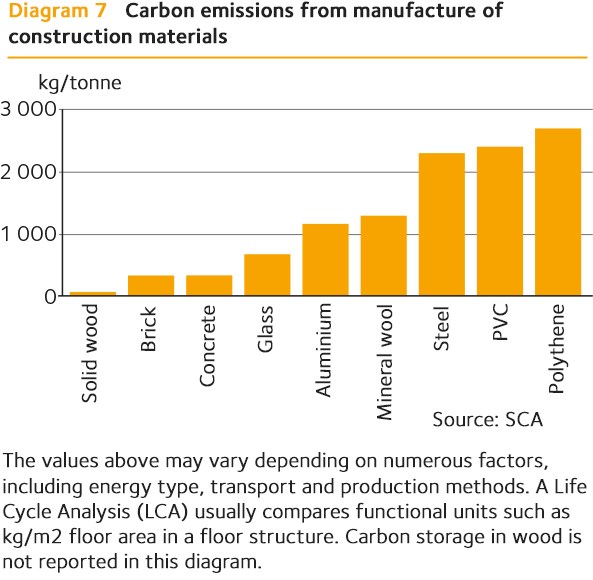
Wood is able to replace other construction materials
Wood can replace other construction materials in many structures while providing the same functionality. One example is that in the Swedish bridge standards (Bronorm) wooden bridges can be designed for the same function and service life as steel and concrete bridges. Such a material substitution could bring significant climate benefits, where wood replaces materials whose production requires fossil fuels and causes high carbon emissions. A study has shown that where wood products replace other construction materials in buildings, there is an estimated average substitution factor of 1.6 tonnes carbon dioxide per cubic metre of wood material, which in an industrially produced apartment with a wood frame adds up to 16 tonnes of carbon dioxide. With greater energy efficiency drives and more climate-smart building, the production phase and thus material choices will take on greater significance, and substitution options will be important.
Environmentally efficient life cycle and ecocycle
All construction materials except wood have a single ecocycle that involves reuse. For wood there are two ecocycles – a shorter one that reuses the component or material, and a longer one that reuses the constituent parts of the wood material via nature’s ecocycle.
We see examples of the shorter ecocycle in the construction industry and in distribution and packaging. Windows, doors and timber can be reused, as can pallets, packaging and cable drums. In all cases, there is an organisation to deal with the products and find new users.
Once wood can no longer be reused or its material recovered, for use in fibreboard and other sheet materials for example, it can still generate energy through incineration. This energy is climate-neutral and is in fact stored solar energy.
To make optimum use of wood in climate terms, it should be carried out in a particular order that is illustrated by the environmental hierarchy for wood (see below). When choosing between different usage options, the alternative that gives the longest period of use should always be chosen, i.e. the one that is higher up the environmental hierarchy. Directly using felled forest for energy production is not optimal – although it is naturally still better for the environment than energy from finite fossil fuels. It is important to note that wood never needs to be sent to landfill.
Environmental objectives
As a member of the UN, Sweden is involved in the negotiations for a global climate agreement. Via our membership of the EU, we are also signed up to its climate objective to halt global warming.
In 2008, the European Parliament voted through a climate package whose overarching objective is to limit the mean global temperature rise to 2°C above pre-industrial levels. The EU has agreed four targets that must be met by 2020. Based on the first three, these targets are often referred to as the 20-20-20 targets.
- Reducing greenhouse gas emissions by at least 20 percent compared with 1990 levels
- Moving towards a 20 percent increase in energy efficiency
- Increasing the share of renewable energy in final energy consumption to 20 percent
- A 10 percent share of renewables in the transport sector
Renewable energy is energy that derives from non-fossil sources. This includes energy from wind power, solar power, hydro power and biofuels. The EU is involved in negotiations for a global climate agreement. Preventing a rise of more than 2°C in the planet’s average temperature will require a major cut in carbon emissions in the near future, according to a report by the UN’s Intergovernmental Panel on Climate Change (IPCC) in September 2013.
Building with wood is positive for the climate
Achieving a climate neutral society depends on greater energy efficiency and wider use of renewable energy sources.
For the construction and real estate sector, this will have an impact on both the production and use phase. For newbuilds, this is about the choice of materials and having a construction process with a low environmental impact and an energy-efficient building at the end of it. For the existing buildings, the focus will largely be on energy efficiencies, since the environmental impact of the construction phase has already happened.
Looking forward to the year 2050, an estimated 80 percent or so of the stock in existence then will be buildings that have already been built today. These must be upgraded to make them fit for the future. It is therefore no coincidence that the greatest focus is on energy efficiencies. We have chosen, however, to present the case for newbuilds, as this gives a complete picture of the system for future building design.
Historically, a building’s operational phase has accounted for the greatest energy consumption during the building’s lifetime, and the production phase has been seen as almost negligible. With the advent of new, increasingly stricter requirements concerning energy use in our buildings, and in an extreme case zero-energy buildings, energy use in the production phase will become increasingly important.
Adapting material choices, designs and production processes to the new conditions is a major challenge for the construction sector. Greater use of wood-based products and wooden structures is a significant part of the solution, due to the material’s carbon storage and substitution effects.
Standards and Environmental Product Declarations
New standards and documents are currently being drawn up as a means of assessing a building’s environmental impact. This work is being conducted internationally, within the EU and in each separate country. In Sweden, SIS is responsible for the standardisation work. The work is being carried out in consultation with businesses and organisations.
In the drive towards the objective that all buildings are built with minimal energy consumption for the production of the construction materials, the construction itself, operation of the building and its demolition and final processing, everyone in the construction process will be affected. For a newbuild, the architects need to present facts about the building’s environmental impact, so that the developer can compare different proposals against each other.
There are currently steering documents and standards that are hierarchically coordinated, as set out below.
The basis for all standards on the environment is ISO 9001 and ISO 14001. Then come the standards for life cycle analyses. ISO 14040, ISO 14044 and ISO 14025 describe how to transfer the results from the life cycle analysis to an Environmental Product Declaration.
Product Category Rules (PCR) setting out how to draw up an Environmental Product Declaration are governed by SS-EN 15804 for building products. SS-EN 15978 specifies the calculation method, based on a life cycle analysis, that is used to assess the environmental performance of the whole building.
The new standards make it possible to calculate and present comparative data on the sustainability of a construction work – throughout its entire life. In order to separate out the different phases of the structure’s life cycle, the standard has been divided up into modules:
- A 1–5: Production of the construction materials and the building
- B 1–7: The building’s use phase
- C 1–4: Demolition of the structure and waste management
- D: Recycling of the construction materials
The modules shown in table 8 are also split into subcategories. The aim is to enable all the data to be separated out so that it is clear where the environmental impact arises and where environmental gains are generated. The standards are not some form of environmental certification, but they can be used as the basis for certification under one of the market’s various certification systems. The developers need to be able to certify their buildings, as this will be required by tenants and the authorities. In simplified terms, the differences between the two methodology standards are that SS-EN 15978 generates data to be able to compare the environmental impact of different buildings, while SS-EN 15804 helps with the declaration of a specific material’s environmental impact. You can never compare wood with concrete or steel. However, you can compare different buildings and see their overall environmental impact. The standards should be used to study how different materials work in different contexts.
Table 8 Environmental assessment of a building
| Life cycle information about the building | Other information | |||
| A 1-3 Production |
A 4-5 Construction |
B 1-7 Operation |
C 1-4 End of life |
D Other information |
| A1 Raw materials A2 Transport A3 Manufacture |
A4 Transport A5 Groundwork and erection plus installations on site |
B1 Use B2 Care and maintenance B3 Repairs B4 Replacement B5 Renovation and retrofitting B6 Energy B7 Water |
C1 Demolition |
Pros and cons outside the system parameters, e.g. environmental certification, energy recovery from wood. |
| Upstream | Central | Downstream | ||
| Detailed information if possible, otherwise from construction database. | Detailed information about manufacture of carcass, transport to and on construction site, energy use and waste when constructing the building. | B1–B5 as per appendix with standard times for maintenance and repairs. Energy use from energy calculation C1–C4, scenario for waste management using current methods. | Report any environmental information or other relevant information about the project.. | |
Källa: Tyréns
The positive properties of wood
Wood is a natural and renewable material that is produced locally for minimum transport needs. The by-products from production are used to generate energy, and the production process creates minimal waste. The material stores carbon dioxide throughout its lifetime, and at the end of its life it can be used as biofuel to replace fossil fuels.
It is possible, for example, to create a lightweight extension on existing foundations, which saves materials, and this is reported in module A. With lightweight movable walls, a retrofit can be completed without any major impact, and this is reported in module B5. And if you can reuse beams or structural elements, that brings considerable savings and can be reported in module D.
Environmental certification of buildings
There is currently no generally accepted way of calculating a building’s climate impact over its whole life cycle, although some construction companies do provide their customers with such calculations.
There are, however, a number of environmental certification systems whose main focus is on the building’s energy efficiency. These systems can be used for newbuilds and existing buildings.
Miljöbyggnad (Eco-building) is a Swedish system, originally based on Boverket’s classifications, that takes account of energy consumption during the period that the building is in use, the indoor environment and documentation on the materials that have been used. Miljöbyggnad does not take account of the construction materials’ impact on the climate.
Green Building is a European system that only takes account of energy consumption during the period that the building is in use.
Leadership in Energy and Environmental Design (LEED) is an environmental certification system from the USA that is more comprehensive than the systems mentioned above. For example, LEED takes greater account of the production phase for the materials used in a building.
The BRE Environmental Assessment Method (BREEAM) comes from the UK and has more or less the same scope as LEED. BREEAM takes account of the production phase to some extent and also considers the environmental impact of the construction materials’ production from a life cycle perspective.
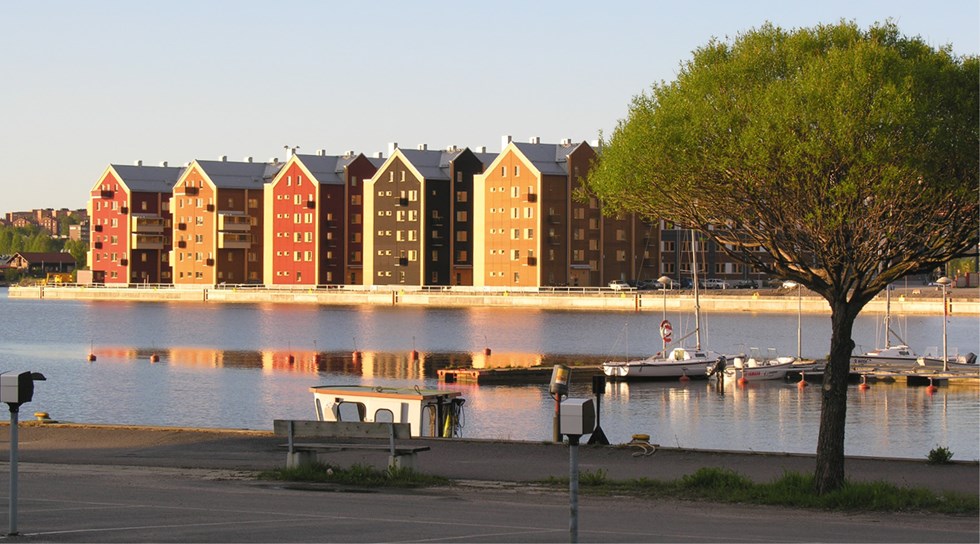
Inner harbour in Sundsvall, five apartment blocks with a structural frame made from cross laminated timber (CLT) and a wooden façade of glulam cladding.
Photographer: Per Bergkvist.

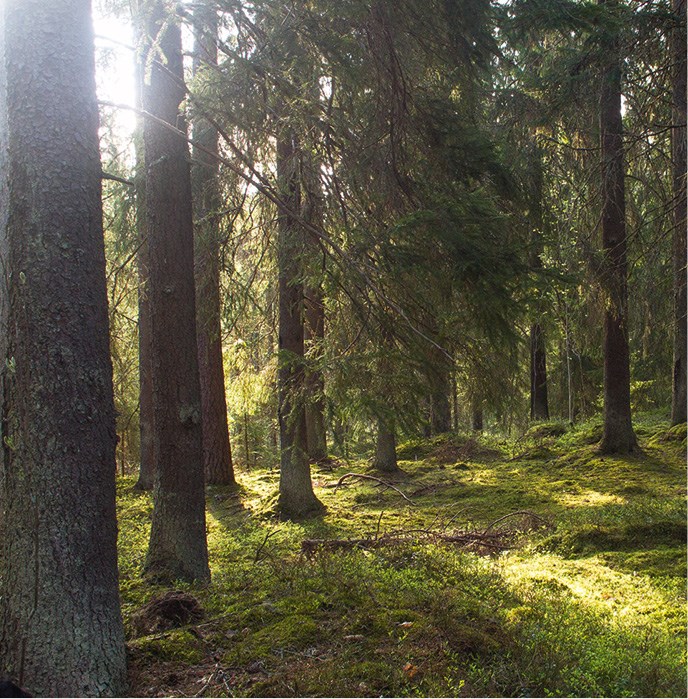 Spruce forest.
Spruce forest.

